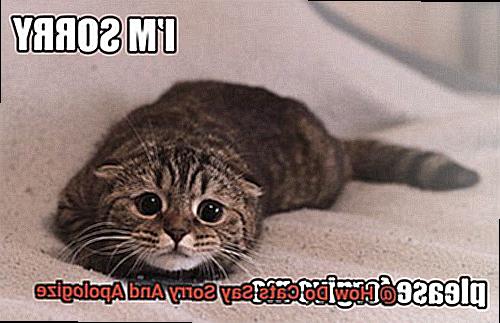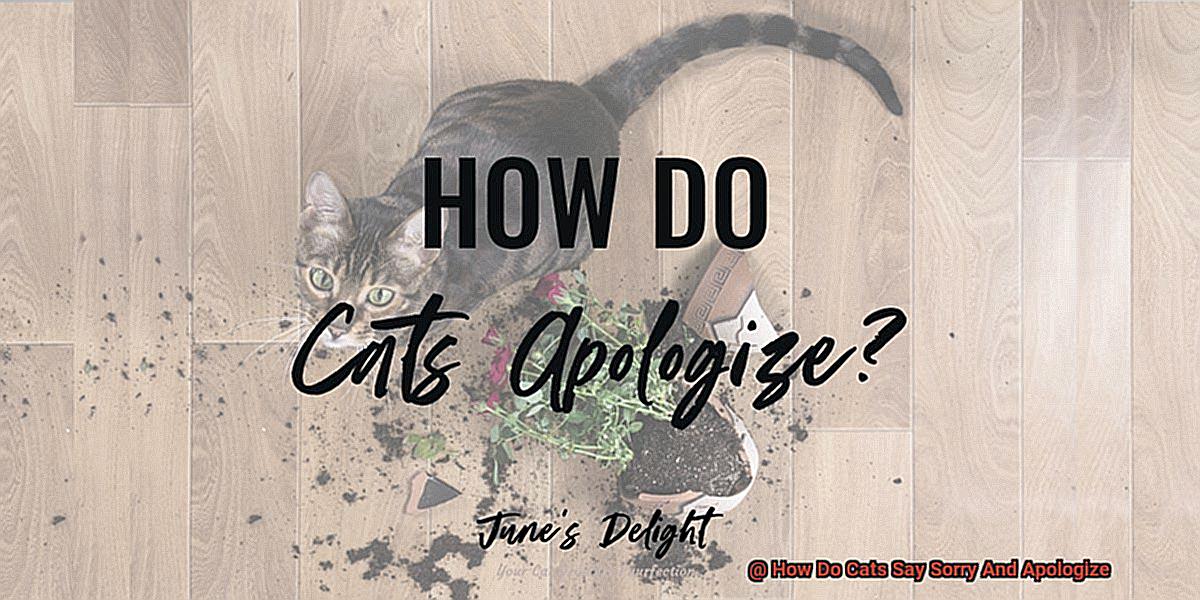Do cats apologize? Many cat owners have asked this question over the years. After all, cats aren’t known for their verbal communication skills. But the truth is that cats do have ways of expressing regret and apologizing – even if they’re subtle.
Head-butting is a common sign of apology from cats. This behavior involves rubbing their head against yours as a way to show love and release endorphins that make them feel calmer and more relaxed. Other signs include purring, licking your hand or face, and rolling over with their stomach exposed – all of which are meant to display submission and contrition.
Vocalizations are another way cats say sorry without words. They can meow softly or trill as an apology. Cats may also bring you dead mice or feathers as an act of repentance.
By observing your cat’s body language, you can learn how they communicate remorse and maybe even forgive them for something they did wrong.
Body Language Apologies
Cats may be independent and aloof, but they also possess a unique way of expressing their emotions – including apologizing. Although cats cannot talk like humans, they can use body language to express remorse and reconcile relationships with other cats and people.
One of the most common body language apologies cats use is lowering their head, flattening their ears, and tucking their tail between their legs. This gesture shows that the cat understands it has done something wrong and is willing to make amends.

In addition to body language, cats can also use soothing sounds to apologize after a fight. Purring is usually a sign of contentment, but it can also be used as an apology to signal that all is well and stability has been restored.
Headbutting or rubbing against another cat or human being is another way cats apologize. Pheromones are released as a calming measure to show that the cat does not pose a threat and wants to make up for any wrongdoings.
It’s important to remember that not all cats will express apologies in the same way; some may not show any signs of regret at all.
Soothing Sounds as Apologies
Cats may be known for their aloofness, but they still have their own special way of conveying their emotions, including apologies. Although cats cannot communicate like humans, they can express remorse in subtle yet effective ways. From purring to body language and headbutting, cats have a variety of methods to apologize.
Purring is one of the most common sounds cats make when apologizing. This sound is normally associated with contentment and pleasure, but it can also be used to indicate remorse. When cats want to show that they are sorry for something they’ve done, they may start purring as a way of calming the other party down and letting them know that all is forgiven.
In addition to purring, cats may also make low meows or growls as a form of apology. These sounds are often seen as signs that the cat is willing to submit and make amends with the other party. Furthermore, cats may use body language such as crouching down or rolling over as an apology gesture.
It’s essential to remember that cats have their own terms when it comes to expressing emotions such as apologies. What might seem like an apology to us humans may not be the same in feline terms. Therefore, it’s important to observe the situation before coming up with any conclusions about what your cat is trying to say.
By understanding how cats apologize we can build a stronger bond with our furry friends and foster a positive relationship with them.
Headbutting and Rubbing as Apologies

Cats are not known for their ability to say sorry in human terms, but they have found subtle yet effective ways to apologize and restore peace. Headbutting and rubbing are two of the most popular gestures cats use to express their affection and remorse.
When a cat headbutts you or another cat, it is an indication of trust and love. It’s also a way for cats to mark their territory by releasing pheromones from their scent glands. Similarly, when a cat rubs against you or another feline, it means they feel comfortable in your presence and want to reaffirm the friendship between them. In some cases, this behavior could be an apology for aggressive conduct or something wrong that has been done.

To accurately interpret your cat’s intentions, pay close attention to their body language. You can build stronger relationships with your feline friend by monitoring their behavior and responding accordingly.
Play-fighting and Making Up
Play-fighting is a common activity among cats and it can sometimes get a bit too rough. When this happens, it’s important to give them some space and time to cool off and recover.
After they’ve had a chance to rest, cats will often approach each other in a friendly manner, such as rubbing up against one another or inviting the other cat to play. They may even play more cautiously than before, demonstrating that they have learned from the experience and don’t want to risk hurting their friend again.
Humans can tell when cats are trying to apologize too – if your cat has mistakenly scratched or bitten you, they may retreat and hide for a period of time before approaching you again. This indicates that they are aware of their mistake and are attempting to make amends in the only way they know how.
Observing Context for an Apology
It can be hard to tell whether your cat is truly sorry or if they are just seeking attention. To get a better understanding of what your cat is trying to tell you, it’s important to observe their behavior and context.
Cats communicate through body language, vocalizations, and scent marking, so paying close attention to these cues can give insight into whether or not they are apologizing. If a cat has acted aggressively towards another cat or human, but then approaches them with a calm demeanor, this could be a sign of regret. Similarly, if a cat has mistakenly knocked something over or scratched furniture and then displays submissive behavior such as crouching, showing the belly, or avoiding eye contact, they may be acknowledging their mistake.
Timing is also an essential factor in discerning whether a cat is apologizing. Cats live in the moment, so if a cat seems to be acting apologetic immediately after a perceived transgression, it could indicate that they are making amends.
However, if the cat does not display any remorseful behavior until much later on in the day, it could mean that they are simply seeking attention or trying to appease their human or feline companion.
Overall, observing context is key when attempting to determine if your cat is apologizing. While cats may not use spoken language to express their emotions and intentions directly, they do have their own unique ways of communicating these things.
Understanding Cat Emotions
Cats may not be able to say sorry like humans do, but they have their own unique way of expressing emotions – and yes, that includes apologizing. By understanding their body language and vocal cues, cat owners can build a stronger bond with their feline friends and provide them with the care and attention they need.
When it comes to saying sorry, cats typically express it through body language. If your cat has done something wrong, look for signs of regret such as lowered ears, tucking their tail between their legs, crouching down or avoiding eye contact – these could all be indications that they are sorry.
In addition to body language, cats may also apologize through other subtle behaviors such as slow blinking or turning their head away. They may even bring you gifts such as toys or small animals as a token of affection or apology.
Understanding cat emotions goes beyond just apologies. Cat owners should be able to recognize when their cat is expressing love, sadness, or gratitude in order to build a closer relationship with them.
KrA8jn1ZIz4″ >
Building a Strong Bond with Your Feline Friend
Creating a strong bond with your feline friend is a rewarding experience that requires patience, love, and understanding. To get started, it’s important to pay attention to your cat’s communication style and respond appropriately.
Cats have developed subtle ways of expressing their emotions, such as slow blinking or headbutting. When your cat approaches you with a slow blink, it means they trust you and consider you a friend – reciprocate this gesture by slowly blinking back at them or offering a gentle pat on the head.
In addition to recognizing their communication style, spend quality time together. Cats enjoy playtime and it’s an excellent opportunity to develop a bond with them. Use toys, laser pointers, or interactive games to keep them engaged and entertained while observing their behavior and learning more about their personality and preferences.
Creating a safe environment is also essential for building a strong bond with your cat. Provide them with a comfortable bed, scratching post, and some toys so they feel secure and loved in their space.
Finally, show them affection by petting them correctly – start by scratching them under their chin or on the back of their neck which helps them relax and feel safe when being petted. Respect their boundaries if they are not in the mood for interaction.
Conclusion
Cats and their owners share a complicated yet delicate relationship. To create a strong bond between the two, it takes patience, understanding and knowledge. Although cats are unable to express themselves in human terms, they have devised their own subtle ways of communicating emotions such as remorse and love – from purring to headbutting and rubbing.
To determine whether your cat is truly sorry or simply seeking attention, it’s important to know their body language and context. After an argument, cats may use play-fighting as a way to make up.
If this happens, give them some space before attempting to resolve the situation.
Positive reinforcement is the best way to develop a lasting friendship with your feline friend. Showing them love, admiration and kindness will promote good behaviour and strengthen the bond between you and your cat.







